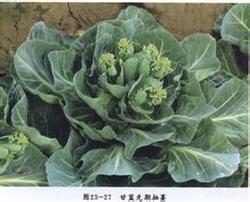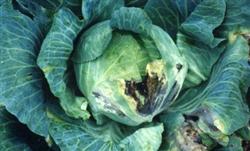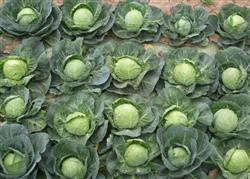Seedling Techniques of Cabbage in Summer, Autumn and Winter

Cabbage in summer, autumn and winter is a common cultivation method in the south and north of China. This cultivation method mainly solves the blank of vegetables in summer and winter off-season and adjusts the market varieties. Moreover, farmers can receive better economic benefits from planting. But this season cultivation, seedling in the high temperature rainy season, seedling survival rate is low, seedling is very difficult. Farmers often say that there is money to buy seeds but no money to buy seedlings, which delays farming time. Therefore, we attach importance to seedling cultivation and master seedling cultivation technology, which is a prerequisite for ensuring successful cultivation. 1. Selection of nursery land Summer seedling selection crops before two years did not plant cruciferous crops, fertile vegetable garden soil, high dry terrain, cool ventilation, good irrigation sandy loam. II. Soil preparation and bed preparation Nursery must be deep several times, add a small amount of decomposed organic fertilizer, so that the soil fine, soft. Make north and south ridges, 1.0-1.2 meters wide, 10-15cm high, 15-20cm drainage ditch between each ridge. Ridge surface must be flat, with flat shoes gently step on, so as not to irrigate small water cracks, affecting seedling, generally 35-40 square meters per mu of seedling ridge can be. III. Variety selection: 1. Summer cabbage: Choose a variety with short growth period, middle maturity and about 60 days of heat resistance, moisture tolerance, disease resistance and insect resistance. Chinese-made summer light, strong summer, imports of the world dragon summer, summer autumn green king, iron ball No. 2 and iron ball No. 3. 2. Autumn, autumn and winter cabbage: early, middle and late maturity are more. China-made Jingfeng, Zhonggan 11, Zhonggan 15, Shuangmei, Shuangyue, Shuangqiang, Late Feng and so on. Imported HBZ-079, HBZ-080, love true, strong winter treasure, Worcester and other varieties. IV. Breadth After the ridge is leveled and stepped on, irrigate small water, not too much, too much water, seeds are easy to rot, high temperature and high humidity conditions are easy to cause seedling diseases; too little water, high summer temperature, large evaporation, dry soil, seeds can not absorb water and expand, affecting seedling emergence, so irrigate water until the 10cm soil layer reaches saturation state. V. Sowing techniques: 1. After water infiltration, sprinkle a layer of sieved fine soil on the surface of the ridge, or use the medicinal soil mixed with medicine (thiram, 8-10 grams per square meter) to paste the cracks. Also called turning soil, to prevent the soil to stick seeds, affecting germination, generally 35-40 grams per mu, summer cultivation density is large, the dosage is relatively large. 2. Sowing: There are two methods, one is sowing and the other is sowing. Used of a nutrient bowl for sowing seeds. In order to sow evenly, use sowing plus fine sand or millet, divided into 2-3 times to sow evenly. For seeding, put 2-3 seeds per bowl. Seed sowing saves labor, seed sowing saves labor. 3. Soil covering: immediately after sowing, soil covering shall be sifted with fine soil or medicinal soil. The soil covering shall not be too thick or too thin. If the seeds are too thick, they will be easily stuffy. If they are too thin, they will be easily capped. The cotyledons cannot be unfolded to absorb nutrients and form tall seedlings or diseased seedlings. Therefore, the soil covering thickness shall be 0.8-1cm. It can also be divided into two times of covering soil, the first time covering 2/3, the last covering 1/3, to prevent the cap from unearthed, covering soil must be sieved fine soil or medicine soil, to prevent seedling disease. VI. Shading and shelter construction Cabbage seeds are small in size, less in nutrients, and poor in adaptability to adverse environmental conditions. Therefore, after sowing, shade sheds should be built immediately to prevent rain and sun protection. Generally, local materials should be used, and straw curtains should be used to cover the ridge surface. The other is to build a shade shed 1 meter high, leaving 30-40cm ventilation channels below, covering old plastic sheets or straw mats, etc., removing the mulch after three days of sowing, forming high-legged seedlings at the end of the evening, which is not conducive to cultivating strong seedlings. If the weather is high three days later, you can return the curtain appropriately. From 11 a.m. to 4 p.m., you can also use sunshade nets to protect against sun. In short, summer high temperature rainy season to carefully manage, cultivate seedlings. VII. SEEDLING In summer, seedling sowing is carried out, and seedlings are divided when two leaves are one, large seedlings are selected and strong seedlings are eliminated, sick seedlings, weak seedlings and insect-bitten seedlings are eliminated, the seedling spacing is generally 10cm, watering is carried out immediately after seedling division, shading is carried out, and the seedlings can be planted when the seedlings grow to 4-5 true leaves, and the seedling age is 25-30 days. Summer and autumn cabbage seedlings and farming activities are arranged in cloudy days or afternoon evening, so as to avoid hot days, serious seedling water loss, affecting the survival rate of seedlings. Eight, seedling diseases and insect pests (a) physiological diseases 1, retting roots: root rust, no root hair, soil moisture is too large, root hypoxia caused, the ground wilting. 2. Root cutting: Underground pests bite root systems and cut roots, resulting in wilting seedlings. (II), disease 1, damping-off disease: seedling disease, seedling stem base was water-like disease spots, then the disease browned, constricted into a linear. When the disease is severe, the seedlings will collapse before the cotyledons wilt. Under high temperature and humidity, a layer of white cotton flocculent hyphae grows on the surface of the host plant and its nearby bed surface. 2, seedling blight: just unearthed seedlings and large seedlings can be damaged, mostly in the middle and late stages of seedling. Oval dark brown spots appear at the base of seedling stem. Early diseased seedlings wilted during the day and recovered at night. The spots gradually depressed and expanded around the stem for one week. Finally, the diseased part contracted and dried up. The whole plant died. The diseased part often had pale brown spider silk net mold. At the same time, there were not obvious white cotton floc, which could be distinguished from damping-off disease. Control methods: 1, seedling bed selection high dry irrigation, fertilizer fully decomposed, loose flat plot. 2. Strengthen seedling bed management, timely ventilation and light transmission of seedlings, proper watering, no flood irrigation, cold and heat preservation of seedlings in spring, and improve seedling disease resistance. 3. Bed soil treatment: treated with chemicals. 1) Formalin: 2-3 weeks before sowing, the bed soil will be raked loose, each square foot of bed soil with formalin 50ml water 4-8 jin (water added depending on the soil humidity) poured on the bed soil, covered with nylon sacks for 4-5 days, remove the cover, raked loose, so that the solution volatilized before sowing. 2) Pentachloronitrobenzene: 70% pentachloronitrobenzene and 50% thiram are mixed evenly, 8-10 grams per square meter, or 50% carbendazim or 50% thiophane can be used alone, and the dosage is the same as before. the above medicinal soil is adde with 20-30 jin of semi-dry fine soil and mixed evenly, 1/3 of that medicinal soil is spread on the bed surface as cushion soil and 2/3 of the medicinal soil is cover on the seeds as covering soil before sowing. 4, chemical control: seedbed found a small number of sick seedlings, timely pull out, can spray, carbendazim and chlorothalonil 1000 times, if humidity plus chlorothalonil or plant ash made of dry fine soil. One is disinfection, the other is to reduce humidity. 5. Plant growth regulator or 5406 seedling fertilizer can improve seedling disease resistance and inhibit disease occurrence. 6. Pest: The main pests are aphids, which are controlled by pyrethroids and imidacloprid. Pieris rapae and diamondback moth can be controlled by biological method or by Bacillus thuringiensis 1000 times or HD-1 pesticide 800-1200 times, dichlorvos, 50% Batan WP 500 times, or by black light lamp. Control must be carried out at the second instar larvae spraying effect is obvious.
- Prev

Control methods of Black Rot of Cabbage
When the main symptoms occur in the adult stage, most of the disease spots develop inward from the leaf margin, showing a "v" shape, which is a yellowish brown withered spot. The leaf tissue around the disease spot is yellowish, and the boundary between the disease spot and the healthy part is not obvious. sometimes the pathogen can develop inward along the leaf vein, forming a reticular yellow vein. The cause of the disease is the initial infection source of the disease is in seeds or soil.
- Next

Explain the reason of "immature bolting" of spring cabbage
Cabbage is a fertilizer-loving and fertilizer-resistant vegetable. Generally, about 35 days after planting, the plant reached the peak of nitrogen, phosphorus, calcium and other elements and absorption, while the absorption of potassium reached the peak at 50 days. Before reaching the peak value, the fertilizer uptake of plants increased linearly with the process of growth period. Cabbage at different growth stages.
Related
- Where is it suitable to grow horseradish in China? it is expected to see the middle altitude horseradish in Alishan.
- How to prevent tomato virus disease reasonably? (Control methods included)
- Many people like to plant towel gourd on the balcony. What are the main points of this method and management?
- What crops can chili peppers be mixed with?
- Fertilization techniques and matters needing attention in Tomato
- What are the grafting techniques for peach seedlings in spring?
- Harm and control methods of root swelling disease of Chinese cabbage
- What are the pests of sweet potatoes? How to prevent and cure it?
- Symptoms, causes and Control methods of navel Rot in Tomato
- The cause of "Cucumber rotten bibcock" in Farmers' planting Cucumber and its Control Plan

